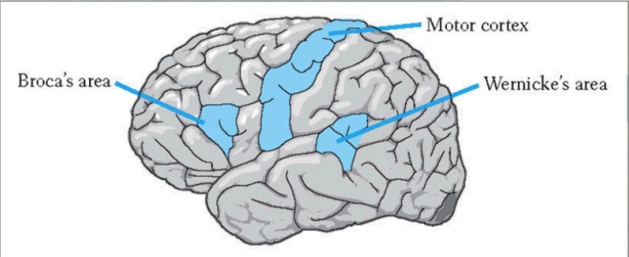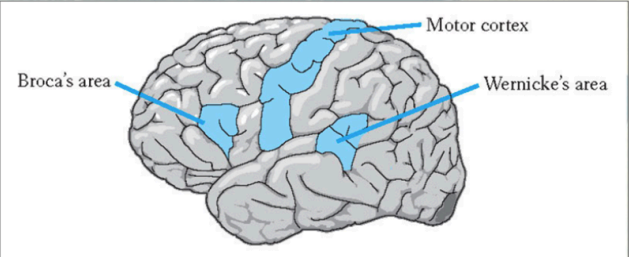Psych 207 - Module 9: Language & Cognition
1/13
There's no tags or description
Looks like no tags are added yet.
Name | Mastery | Learn | Test | Matching | Spaced |
|---|
No study sessions yet.
14 Terms
Two Aspects of Language - Arbitrary/Generative
Arbitrary (Symbolic)
Definition:
Words are symbols with no inherent link to what they represent.
Example: The word “dog” has no natural connection to the animal; it’s just agreed upon.
Generative (Creative)
Definition:
Language allows infinite new combinations of words to create new ideas, sentences, or songs.
Example: You can say a sentence that has never been spoken before.
5 Levels of Language Structure
Phoneme: Smallest sound unit (e.g., /m/ vs. /c/).
Morpheme: Smallest meaning unit (e.g., cat + s).
Syntax: Rules for word order and sentence structure.
Pragmatics: Social rules & context of communication.
Semantics: Meaning of words and sentences.
Phonemes
Definition: Smallest unit of sound that can change meaning.
Key Points:
Learning new phonemes is often hardest part of learning a language.
Some phoneme combinations are illegal in a language, and we notice violations instantly.
Example:
/b/ vs. /p/ → “bat” vs. “pat”
“tl” at the start of a word is illegal in English.
Morphemes
Definition: Smallest unit of meaning in a language.
Key Points:
Many morphemes are words, but not all.
Prefixes, suffixes, tense markers count as morphemes.
Examples:
“studied” → stud + y (2 morphemes)
“redoing” → re + do + ing (3 morphemes)
Syntax
Definition: Rules for arranging words in sentences.
Key Points:
English is SVO (Subject-Verb-Object).
We have implicit understanding of syntax that goes beyond what we can explain.
Syntax ≠ meaning → grammatically correct sentences can still be meaningless.
Example:
“The cat chased the dog” → syntactically correct
“Dog the chased cat the” → incorrect
Semantics
Definition: The meaning of words and sentences.
Key Points:
Explains why some sentences are syntactically correct but meaningless.
Important elements:
Anomaly: Sentence is syntactically correct but makes no sense. Words don’t logically go together in meaning.
eg. “Coffee ice cream can take dictation”
Contradiction: Grammatically correct, but semantically false.Dogs are animals → sentence violates real-world knowledge
eg. “My dog is not an animal”
Ambiguity: “The chicken is ready to eat” (Two possible meanings)
Synonym: Two sentences or phrases have the same meaning. You are too young” = “You are not old enough”
Entailment: If one sentence is true, another must also be true. Pat is my uncle” → implies Pat is male
Comprehending Speech
Naive view:
Comprehension = perceive and identify every phoneme & morpheme and where they start and end.
Problem:
Speech is continuous → there are no clear breaks between words in natural speech.
Coarticulation:
A phoneme’s sound changes depending on surrounding phonemes.
Example: The /p/ in “pin” vs. “spin” sounds slightly different.
Theory of Language Processing
Our language processing system:
Forces continuous sound into discrete categories → maps onto the phonemes of our language.
Explains why we can understand speech despite variability in how sounds are produced.
Speech Errors
Common in language production and follow predictable patterns:
Phoneme exchanges:
Example: “You have hissed my mystery lectures” instead of “missed my history lectures.”
Morpheme exchanges:
Example: “He has already trunked two packs” instead of “packed two trunks.”
Key Insight:
Errors respect language rules → our brain organizes speech using phonemes & morphemes, showing the system is rule-governed.
Only phonemes moved, but the structure stayed legal → you didn’t produce an impossible word.
Language Development & Aphasias
Comprehension develops before production → Babies understand words before they can speak.
Aphasia = Impairment of language comprehension or production
Broca’s Aphasia (Expressive Aphasia)
Location: Damage to Broca’s area in frontal lobe, left hemisphere.
Symptoms:
Halting, effortful, agrammatic speech (broken sentences).
Can express meaning with nouns & verbs, but function words and syntax impaired.
Good comprehension, but poor production.
Example:
Want to say: “The dog chased the boy”
Might say: “Dog… chase… boy.”
Extra Difficulty:
Struggles with syntax-dependent comprehension (e.g., “The boy was bitten by the dog”).

Wernicke’s Aphasia (Receptive Aphasia)
Location: Damage to Wernicke’s area in temporal lobe, left hemisphere.
Symptoms:
Fluent but nonsensical speech (“word salad”).
Poor comprehension → cannot follow simple commands (e.g., “Touch your knee”).
Speech sounds normal in rhythm, but lacks meaningful content.
Analogy:
Like hearing a foreign language → speech flows but meaning is lost.

Anomia, Alexia, Agraphia, Alexia without Agraphia
Anomia: Difficulty naming objects.
Alexia: Reading impairment (visual language).
Agraphia: Writing impairment.
Alexia without Agraphia: Can write but cannot read what they wrote.

Neurological Insights
Language is lateralized → mostly in left hemisphere.
Different components of language (speech, comprehension, reading, writing) are localized in separate brain regions.
Evidence: Specific damage leads to specific deficits (double dissociation).
Motor cortex → Frontal lobe → Controls speech muscles